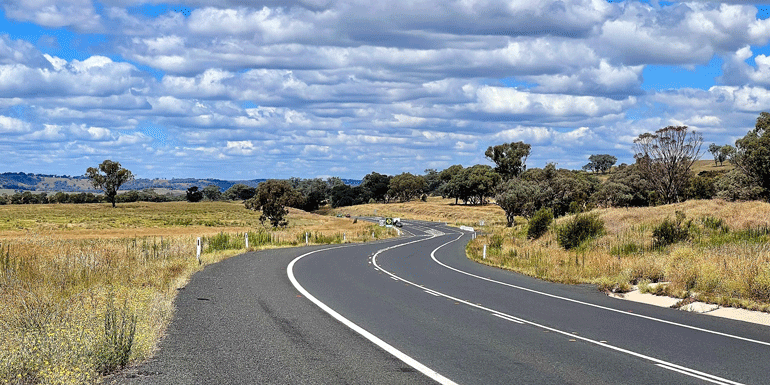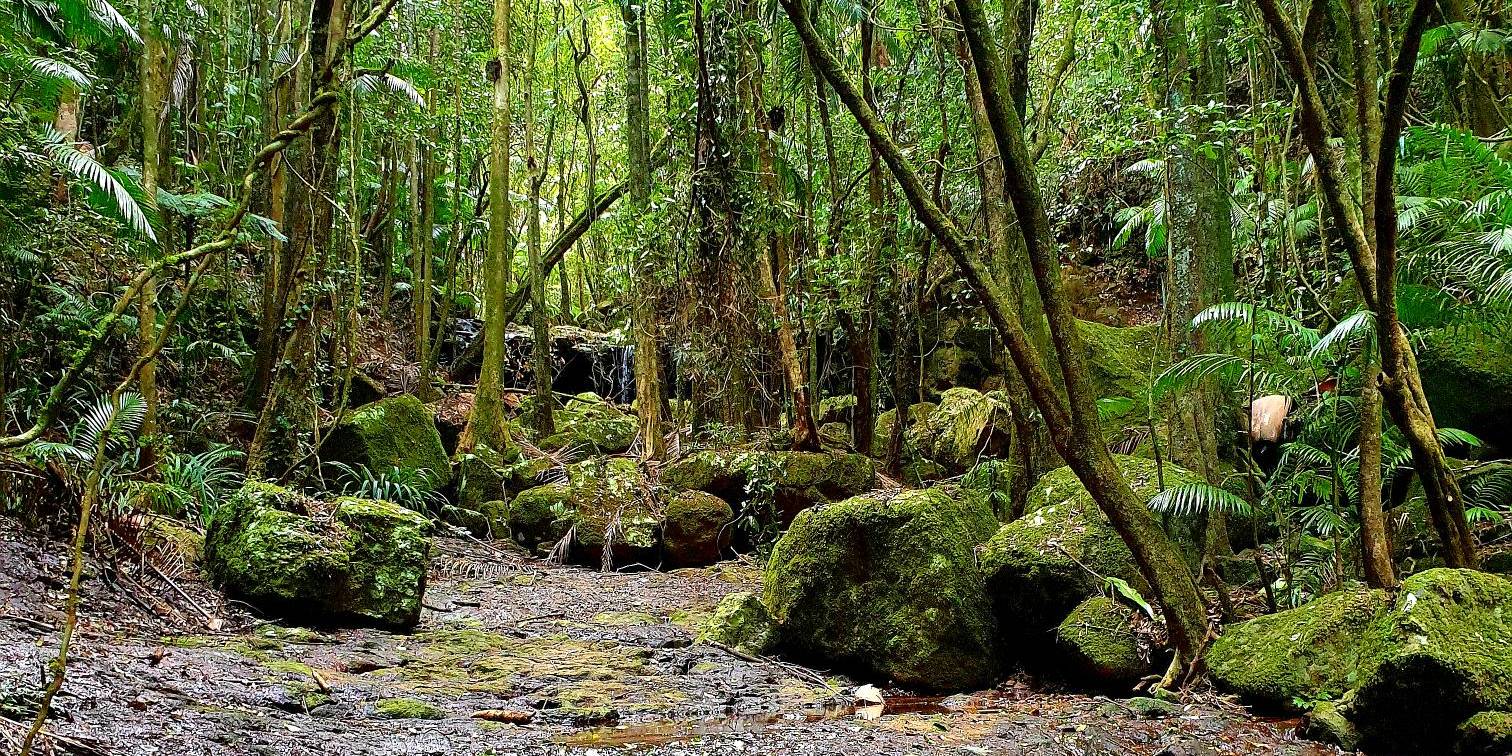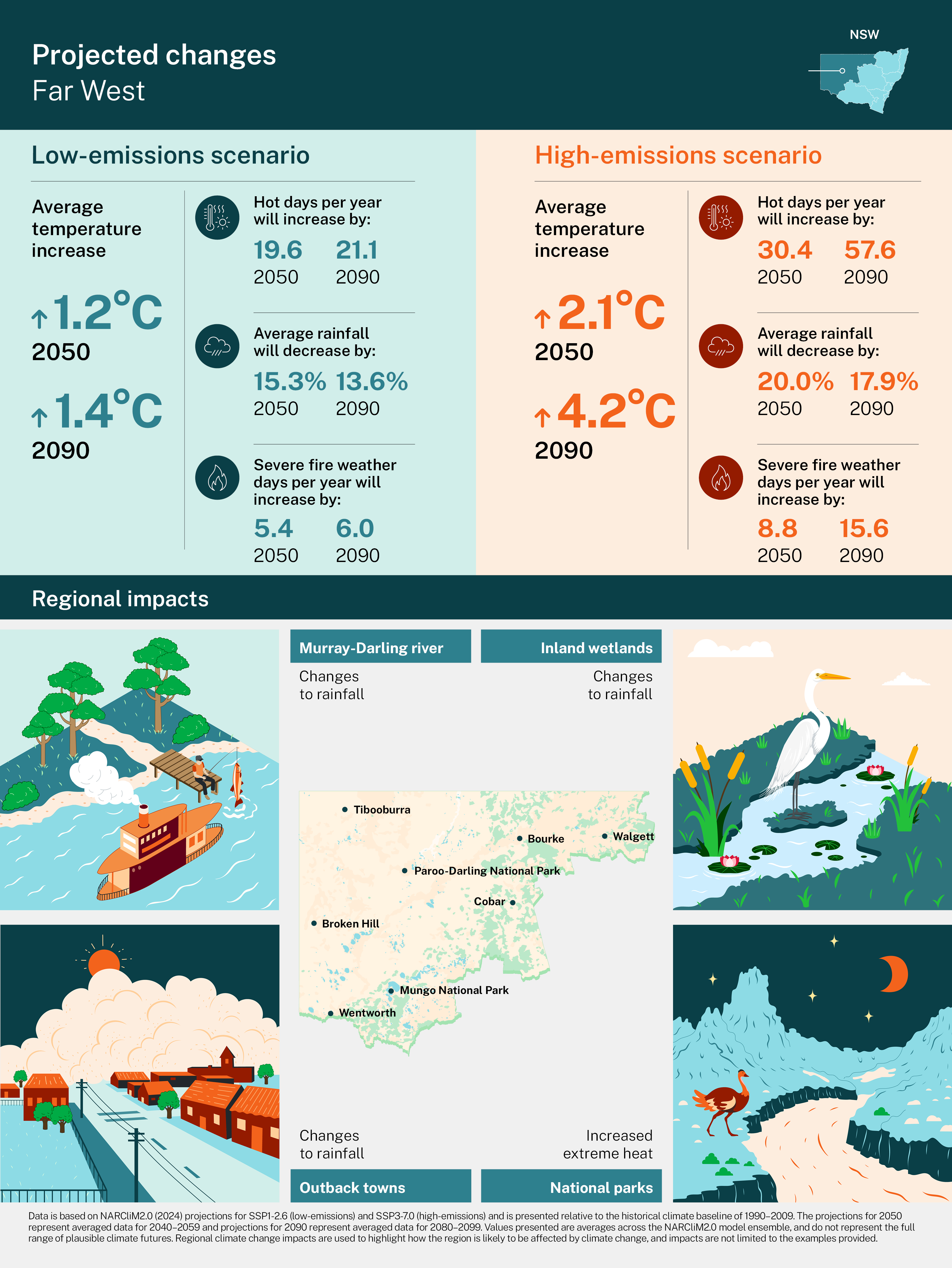Key points
- The Far West region is the largest in area in NSW, covering 40% of the state, and contains fragile environments which are home to a diverse range of native species.
- The region supports industries including agriculture, tourism and mining, and has a rich cultural heritage, with 30,000-year-old Aboriginal rock carvings and many pastoral and mining heritage places.
- Climate change is affecting the Far West region, particularly through increasing temperatures. Projections show temperatures are expected to keep rising, rainfall patterns will change and droughts will be more severe.
- The NSW Government is helping Far West region adapt to climate change through the Enabling Regional Adaptation work. This is being achieved by working with state and local government stakeholders to identify key aspects of the Far West region that are vulnerable to climate impacts, along with challenges and opportunities to adapt.
Importance of the Far West region
The Far West is the largest region in NSW. It extends to the Queensland border in the north, South Australian border to the west and the Victorian border to the south. Broken Hill is the largest town which services remote towns such as Bourke, Cobar and Walgett. The Barwon–Darling River system connects Far West communities to each other and to the southern regions such as Wentworth and Balranald shires.
The landscape of the region is mostly flat, which supports wide floodplains and tributaries into the Darling River. The region has a high diversity of species and ecosystems, including the internationally recognised Willandra Lakes Region World Heritage Area, 6 national parks and 12,462 Aboriginal cultural heritage sites.
Iron ore mining is currently the largest economic contributor, while the agricultural sector employs the most people. Tourism, renewable energy, arts and culture are emerging industries in the region.
These environmental, economic and cultural values are just some aspects of the region which have been identified as being highly vulnerable to climate change. Climate change is already affecting the Far West region, particularly through increased temperatures. The impacts of this can be seen through recent prolonged drought conditions.
How the Far West region is affected by climate change
The Far West is getting warmer
The warmest year on record for both average temperature and maximum temperature in the Far West region was 2019, when average temperature was 1.1°C above the 1990–2009 average.
Projected warming
Across the Far West, average temperatures will continue to increase throughout this century. By 2090, average temperature is projected to rise by around 1.4 °C under a low emissions scenario and around 4.2°C under a high emissions scenario.
Interpreting the projections
The projections provide a summary of plausible future climate change in the Far West relative to a baseline of average climate from 1990–2009. Unless otherwise specified, the presentation of data on this page is averaged across a 20-year period from the NARCliM model ensemble. For example, the projections for 2050 represent averaged data for 2040–2059 and projections for 2090 represent averaged data for 2080–2099. In translating the projections, it is important to consider the previous historical changes that occurred prior to 1990-2009. For example, national temperature records indicate that NSW has warmed by 0.84°C between 1910-1930 and the 1990-2009 baseline.
Detailed information on the projected climate changes for the Far West region can be found in the Far West Climate change snapshot or explored further through the interactive climate projections map.
The annual number of hot days 35°C and above is projected to increase for the Far West by 2050. By 2090, under a high-emissions scenario, parts of the Far West are projected to experience nearly double the annual number of hot days, compared with the 1990–2009 average.
Northern areas of the region such as Bourke and Walgett are projected to experience the greatest increases in the number of hot days, with some areas to experience hot days more than one third of the year.
The annual number of cold nights below 2°C is projected to decrease for the Far West by 2050. By 2090, under a high-emissions scenario, there is projected to be a greater than 95% reduction in the annual number of cold nights for the region, compared with the 1990–2009 average.
The greatest decreases in the number of cold nights are projected to occur in the east of the region.
Annual average rainfall in the region is projected to remain variable throughout this century. On average, spring rainfall is projected to decrease by approximately 30% by 2090. Areas in the north and west of the region, such as Tibooburra and Broken Hill, are projected to experience greater decreases.
On average, the annual number of severe fire weather days is projected to increase for the Far West by 2050. By 2090, under a high-emissions scenario, the number of annual severe fire weather days is projected to more than double in northern areas of the region, compared with the 1990–2009 average.
Adapting to changes in the Far West region
To help the Far West region adapt to the impacts of climate change, state and local government stakeholders were brought together in 2016 as part of the NSW Government’s Enabling Regional Adaptation work.
These participants collaboratively identified how different economic, sociocultural and environmental aspects (also known as systems) in the region are vulnerable to climate change. For each of these systems, the vision for a climate-resilient future was identified, and opportunities for action were co-designed. These opportunities can be implemented by state and local government, businesses or community groups.
The Western Enabling Regional Adaptation – Far West region report provides a resource for state and local government and regional communities to understand how climate change will continue to impact the region and our values. It also provides potential opportunities for governments, businesses and communities to adapt to climate change.
The following opportunities for action reflect potential options for state and local government, businesses or community groups to implement. This list has been summarised from the Western Enabling Regional Adaptation – Far West region report. These opportunities provide a starting point for action, and will be reviewed and updated to ensure they continue to reflect climate trends, key vulnerabilities and community values.
Vision
Small, remote communities that are separated by large distances have stabilised populations and are supported by the development of Broken Hill. Far West towns are resilient with climate-smart housing and infrastructure, with access to essential services. Long-term strategic planning attracts people to the region and the economy is diversified to reduce reliance on agriculture and mining.
Opportunities for action
- Support stronger regional settlements with coordinated physical and social infrastructure adapted to climate and community needs.
- Develop and support strong Far West voices to advocate for regional priorities, opportunities and investments.
Vision
The Far West economy that supports vibrant and sustainable industries offering diverse employment opportunities through a commitment to regional development and innovation. Investments are made in supporting infrastructure, such as telecommunications and public transport, innovative remote regional health and education services. By 2050, the Far West economy is supported by a diversified and sustainable skilled workforce.
Opportunities for action
- Develop and invest in innovative services and technologies that support an inclusive, diversified and vibrant economy.
- Invest in remote health technology, such as telehealth and video services.
- Increase access for local contractors to deliver goods and services.
Vision
The tourism sector supports and grows the visitor economy to Broken Hill and throughout the Far West region. Tourism contributes to a thriving regional economy, drawing on its unique experiences in eco-tourism and cultural heritage, boosting visitation for events and conferences. The sector is supported by fast IT and communications infrastructure, secure water supplies, and improved transport links for increased access.
Opportunities for action
- Encourage collaborations to grow and promote a range of tourism opportunities and hospitality services. Tourism opportunities include cultural heritage tourism, ecotourism and the Broken Hill Festival.
- Improve transport links to the region through sealed roads, increased flights and rail services.
- Encourage collaboration within the tourism industry and between stakeholder groups.
Vision
The prosperity of remote settlements is underpinned by a secure, continued supply of water for multiple uses. Regional water sources are governed under water-sharing plans secured for the community, industry and the environment using effective urban design and efficient infrastructure. Environmental flows are secured to support ecosystems, and water harvesting and storage are improved through appropriate infrastructure.
Opportunities for action
- Reform the planning and assessment process for water and infrastructure projects.
- Educate and engage the community so they can participate in water-use planning and decision-making.
- Provide funding and incentives to protect and improve vegetation along rivers, and wetlands.
- Design and build water-efficient developments.
Vision
Rangeland grazing and conservation on private lands recognises that healthy ecosystems support biodiversity and enhance food security. The grazing system consists of diverse, future-oriented family farms in biodiverse landscapes and is supported by payments for ecosystem services. The government partners with landowners to share the cost of conservation, and high conservation value sites are protected.
Opportunities for action
- Encourage and promote alternative land uses to diversify farm businesses.
- Encourage private land conservation.
- Provide stable policy and incentives for improvements.
- Maintain and facilitate family farms as a viable business option.
- Develop ecotourism to fund conservation.
Vision
The Far West energy system is decentralised, with renewable energy generation that is secure, reliable and cost-effective. Community owned clean energy powers energy efficient buildings with increased human comfort, and local transport and infrastructure use renewable energy to reduce emissions. The Far West is a recognised market leader in clean energy technology and provides energy to neighbouring regions.
Opportunities for action
- Establish incentives and strategies to encourage innovative systems and investment, to support clean energy generation and storage.
- Support the regional workforce to transition to clean energy jobs, though training and reskilling.
- Encourage culture change to transform energy use in the region.
Vision
The Far West reserve system maintains diverse natural and cultural values which are integrated across private land and the NSW reserve system. Healthier landscapes support and conserve regional biodiversity. Investments have improved the monitoring and knowledge of species populations, leading to appropriate adaptive management. The reserve systems use traditional owners in park management, and increased employment is created through Aboriginal businesses that align with reserve values, such as bush foods.
Opportunities for action
- Promote the use of new technologies and partnerships to better integrate land conservation for community decision-making and planning.
- Integrate private land conservation with the public reserve system.
- Increase ecotourism to the region.
How we’ve adapted so far
With the knowledge and partnerships gained through the Far West Enabling Regional Adaptation work, there is an opportunity for council, government and communities to show leadership and consider this work in their plans to respond to climate change.
Some opportunities for action are already being addressed by government, community, households and business, to help the Far West adapt to the impacts of climate change and build a sustainable, productive and equitable future.
One example of action being taken is a water-resilient community garden by Dharriwaa Elders Group Incorporated. This project renewed a community garden, making it more resilient to drought, and reducing greenhouse gas emissions from food transport by providing local food for the community.
Other examples include the projects supported by the Building Resilience to Climate Change grants and Increasing Resilience to Climate Change grants.
The Enabling Regional Adaptation work has already been used to inform government planning in the Far West region, through the Far West Regional Plan 2036. Incorporating this work into regional and state plans ensures climate change risks specific to the Far West are included.
If you have an example of how a community group, business or local government is adapting to climate change, email AdaptNSW so we can share your story.
Related Information
NSW Department of Primary Industries
NSW Department of Planning, Industry and Environment
Local Government NSW climate change adaptation resources
National Climate Change Adaptation Research Facility
Far West region – NSW Government
Case studies

NSW councils are building climate risk into their business-as-usual planning and policies for the first time, thanks to products developed using NARCliM’s locally relevant climate modelled data.

The NSW Government has created the first holistic adaptation plan to protect a World Heritage rainforest from climate change impacts – and now ground-breaking genetic science is giving some rare and threatened species a helping hand to adapt and evolve.

